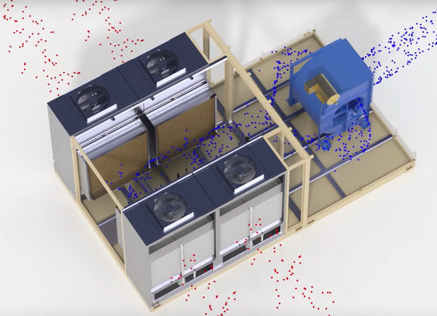When the summer heat causes a dangerous increase in temperature inside a building, worker productivity goes down and injury risk goes up. Both problems can be mitigated by investing in a ventilation system upgrade. However, there is a certain order to improving a ventilation system where all of the components are working together to deliver a cost-effective solution. In this article, I’ll go through the progressive levels of building the best ventilation system for your facility.
Level 1 – Ambient Conditions
The first level of any ventilation system is to make the temperature and humidity conditions inside the building the same as the outside. Radiated heat from the building’s roof and walls combined with any heat generated from machines, ovens or furnaces can significantly raise the inside temperature. Also, tight building envelopes can be a trap for humidity resulting in condensation. Eliminating excess heat and humidity requires designing a ventilation system that will consistently move a sufficient volume of ambient air through a building.
A powered ventilation system utilizing appropriately sized fans to provide the required air change rate to obtain ambient conditions inside a building is the most cost-effective solution. The best Level 1 ventilation system designs will take into consideration:
- Building height and orientation
- Wind direction and obstructions
- Supply and exhaust air locations
- Other internal air requirements for dust collection or combustion
Level 2 – Personal Cooling
 When the air temperature gets too hot, the body tries to cool itself by producing sweat. Using a fan to increase the evaporation of sweat provides the sensation of cooling. Personal cooling fans are considered the second level to any building ventilation system because they are working at their most effective level when the building is at ambient conditions. Too often, we hear customers say they want to skip the first level of ventilation and go straight to HVLS fans. The danger in doing that is these fans can blow very hot air from the top of the building on to workers and actually make them feel hotter.
When the air temperature gets too hot, the body tries to cool itself by producing sweat. Using a fan to increase the evaporation of sweat provides the sensation of cooling. Personal cooling fans are considered the second level to any building ventilation system because they are working at their most effective level when the building is at ambient conditions. Too often, we hear customers say they want to skip the first level of ventilation and go straight to HVLS fans. The danger in doing that is these fans can blow very hot air from the top of the building on to workers and actually make them feel hotter.
Because personal cooling fans don’t actually cool the air, they are only effective when their air streams are directed to where workers are present. Column or floor mounted fans work best for relatively stationary workers. HVLS fans hung from roof joists are a more cost-effective solution for covering a larger area. They are also good for moving air to minimize condensation on concrete floors.
 Level 3 – Indirect Evaporative Cooling
Level 3 – Indirect Evaporative Cooling
When more cooling is required but the high cost of air conditioning is probative, an indirect evaporative cooler (IEC) can take a ventilation system to the next level. An IEC unit provides the same cooling effect as a “swamp cooler” without the added humidity. If a building already has an effective Level 1 or 2 ventilation system, it is possible to achieve a 15 degree reduction in temperature inside a building without making any additional modifications beyond adding the IEC unit.
Design Based on Need
Whatever level of ventilation your needs are currently, the experts at Eldridge know how to assess and design the best ventilation system for your facility. We can also help you quantify the payback from your investment. Eldridge makes the process of improving your ventilation system simple with our customized turnkey solutions. Don’t let the temperatures rise too high before contacting an Eldridge ventilation specialists to help you create a successful environment in your facility.
